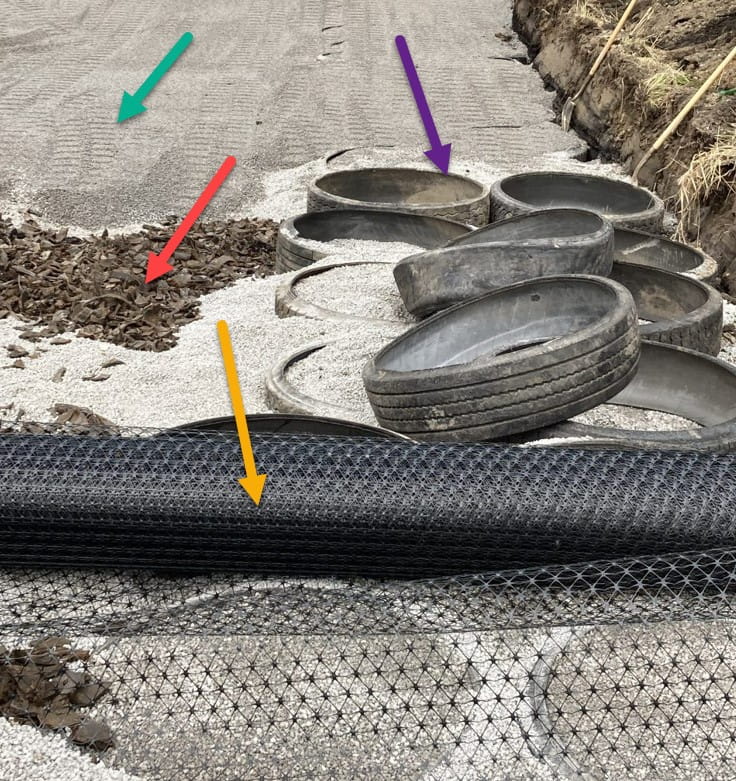The web Browser you are currently using is unsupported, and some features of this site may not work as intended. Please update to a modern browser such as Chrome, Firefox or Edge to experience all features Michigan.gov has to offer.
Ingham County ‘road lasagna’ a model technique that uses scrap tires
June 28, 2023
As part of National Tire Safety Week (NTSW), today’s MI Environment story highlights an Ingham County road construction project using scrap tires.
The road construction crew calls it ‘road lasagna’ – roads that are made with scrap tires and other construction materials that are layered like sheets of pasta in the Italian dish. The construction method has been used for many years using different construction materials, but using scrap tires in the layers is getting more common in Michigan thanks to grants from the Michigan Department of Environment, Great Lakes, and Energy (EGLE).

Ingham County road lasagna project. Purple arrow: Scrap semi tire rings; Red arrow: Tire Derived Aggregate (shredded scrap tires with wire left in); Green arrow: Aggregate; Yellow arrow: Geotextile fabric.
In 2021, EGLE awarded an $80,000 match grant to Ingham County to build some 325 lineal feet of road on top of a scrap tire base near Onondaga.
That section of Belleview Road, just west of Byrum Road, in Ingham County is in a wet area and had been sinking. It was rebuilt using the “road lasagna” stacking method. It is now complete and showing positive results, says Kirsten Clemens, EGLE’s scrap tire coordinator.
“The project involved the crew removing over 30 inches of old asphalt from that segment of road,” noted Clemens. “Previous ‘fixes’ were to add a layer of asphalt when the road got low, which just caused it to sink faster.”
Describing the construction in 2022, Clemens noted: “The scrap semi tire ‘rings’ were prepared with the sidewalls cut out. They were placed touching in two rows in the bottom of the trench and filled with aggregate. A layer of aggregate is put over top, then a layer of tire derived aggregate (TDA) and a layer of geotextile fabric. This process was repeated three times, and the surface was prepared and paved.”
In all, the project used approximately 30,000 scrap tires.
NTSW highlights the environmental and public health benefits of properly maintained tires: conserving fuel and reducing air pollution; extending the life of tires and reducing waste; and helping to protect human health through proper reuse, recycling, or disposal.
Other Michigan roads projects using scrap tires in tire derived aggregate (TDA) construction projects include Eastman Road in Midland County and an upcoming project with the Ingham County Road Commission.
EGLE’s scrap tire program is responsible for overseeing the handling of scrap tires generated in Michigan, cleaning up existing scrap tire piles of 500 or more tires, and expanding the reuse and recycling of scrap tires.
Interested in where to recycle used tires? Check out EGLE’s Give Your Tires New Life card.